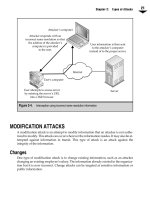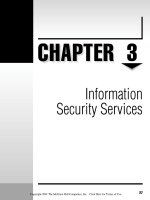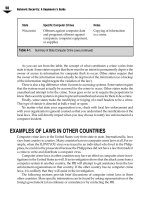Bảo mật hệ thống mạng part 1 potx
Bạn đang xem bản rút gọn của tài liệu. Xem và tải ngay bản đầy đủ của tài liệu tại đây (338.63 KB, 10 trang )
PART
I
Information Security
Basics
1
Copyright 2001 The McGraw-Hill Companies, Inc. Click Here for Terms of Use.
This page intentionally left blank.
CHAPTER
1
What Is Information
Security?
3
Copyright 2001 The McGraw-Hill Companies, Inc. Click Here for Terms of Use.
4
Network Security: A Beginner’s Guide
I
nformation security does not guarantee the safety of your organization or your infor
-
mation or your computer systems. Information security cannot, in and of itself, provide
protection for your information. That being said, information security is also not a
black art. There is no sorcery to implementing proper information security and the concepts
that are included in information security are not rocket science.
In many ways, information security is a mindset. It is a mindset of examining the
threats and vulnerabilities of your organization and managing them appropriately. Un
-
fortunately, the history of information security is full of “silver bullets” that did nothing
more than side-track organizations from proper risk management. Some product ven
-
dors assisted in this by claiming that their product was the solution to the security problem.
This chapter (and this book) will attempt to identify the myths about information se
-
curity and show a more appropriate management strategy for organizations to follow.
DEFINING INFORMATION SECURITY
According to Merriam-Webster’s online dictionary (www.m-w.com), information is
defined as:
Knowledge obtained from investigation, study, or instruction, intelligence, news, facts,
data, a signal or character (as in a communication system or computer) representing data,
something (as a message, experimental data, or a picture) which justifies change in a construct
(as a plan or theory) that represents physical or mental experience or another construct
And security is defined as:
Freedom from danger, safety; freedom from fear or anxiety
If we put these two definitions together we can come up with a definition of informa
-
tion security:
Measures adopted to prevent the unauthorized use, misuse, modification, or denial of use
of knowledge, facts, data, or capabilities
That definition encompasses quite a lot. It talks about all measures, whatever they
may be, to prevent bad things from happening to knowledge, facts, data, or capabilities.
We are also not limited to the form of the information. It might be knowledge or it might
be capabilities.
However, this definition of information security does not guarantee protection. Infor
-
mation security cannot guarantee protection. We could build the biggest fortress in the
world and someone could just come up with a bigger battering ram.
Information security is the name given to the preventative steps we take to guard our
information and our capabilities. We guard these things against threats, and we guard
them from the exploitation of a vulnerability.
Chapter 1: What Is Information Security?
5
BRIEF HISTORY OF SECURITY
How we handle the security of information and other assets has evolved over time as our
society and technology have evolved. Understanding this evolution is important to un
-
derstanding how we need to approach security today (hence the reason I am devoting
some space to the history of security). The following sections follow security in a rough
chronological order. If we learn from history, we are much less likely to repeat the mis
-
takes of those who came before us.
Physical Security
Early in history, all assets were physical. Important information was also physical as it
was carved into stone and later written on paper. (Actually, most historical leaders did
not place sensitive/critical information in any permanent form, which is why there are
very few records of alchemy. They also did not discuss it with anyone except their chosen
disciples—knowledge was and is power. Maybe this was the best security. Sun Tzu said
“A secret that is known by more than one is no longer a secret.”) To protect these assets,
physical security, such as walls, moats, and guards, was used.
If the information was transmitted, it usually went by messenger and usually with a
guard. The danger was purely physical. There was no way to get at the information with-
out physically grasping it. In most cases, the asset (money or written information) was
stolen. The original owner of the asset was deprived of it.
Communications Security
Unfortunately, physical security had a flaw. If a message was captured in transit, the in-
formation in the message could be learned by an enemy. As far back as Julius Caesar, this
flaw was identified. The solution was communications security. Julius Caesar created the
Caesar cipher (see Chapter 12 for more information on this and other encryption systems).
This cipher allowed him to send messages that could not be read if they were intercepted.
This concept continued into World War II. Germany used a machine called Enigma
(see Figure 1-1) to encrypt messages sent to military units. The Germans considered
Enigma to be unbreakable; if it had been used properly, it certainly would have been very
difficult. As it was, some operator mistakes were made and the Allies were able to read
some messages (after a considerable amount of resources were brought to bear on the
problem).
Military communications also used code words for units and places in their messages.
Japan used code words for their objectives during the war and that made true understand
-
ing of their messages difficult even though the United States had broken their code. During
the lead-up to the Battle of Midway, American code breakers tried to identify the target ref
-
erenced only as “AF” in Japanese messages. They finally had Midway send a message in
the clear regarding a water shortage. The Japanese intercepted the message and sent a
coded message noting that “AF” was short of water. Since the Americans were reading the
Japanese messages, they were able to learn that “AF” was in fact Midway.
6
Network Security: A Beginner’s Guide
Messages were not the only type of traffic that was encoded. To guard against the en
-
emy listening to voice messages, American military units used Navaho Code Talkers.
The Navaho spoke their native language to transmit messages; if the enemy was listening
to the radio traffic, they would not be able to understand the messages.
After World War II, the Soviet Union used one-time pads to protect information trans
-
mitted by spies. The one-time pads were literally pads of paper with random numbers on
each page. Each page was used for one message and only one message. This encryption
scheme is unbreakable if used properly, but the Soviet Union made the mistake of not us
-
ing it properly (they reused the one-time pads) and thus some of the messages can be de
-
crypted.
Emissions Security
Aside from mistakes in the use of encryption systems, good encryption is hard to break.
Therefore, attempts were made to find other ways to capture information that was being
transmitted in an encrypted form. In the 1950s, it was learned that access to messages could
be achieved by looking at the electronic signals coming over phone lines (see Figure 1-2).
Figure 1-1.
The Enigma machine
Chapter 1: What Is Information Security?
7
All electronic systems give off electronic emissions. This includes the teletypes and
the encryptors being used to send encrypted messages. The encryptor would take in the
message, encrypt it, and send it out over a telephone line. It was found that electric sig-
nals representing the original message were also found on the telephone line. This meant
that the messages could be recovered with some good equipment.
This problem caused the United States to create a program called TEMPEST. The
TEMPEST program created electrical emissions standards for computer systems used in
very sensitive environments. The goal was to reduce emissions that could be used to
gather information.
Computer Security
Communications and emissions security were sufficient when messages were sent by
teletype. Then computers came on the scene and most of the information assets of organi
-
zations migrated on to them in an electronic format. Over time, computers became easier
to use and more people got access to them with interactive sessions. The information on
the systems became accessible to anyone who had access to the system.
In the early 1970s, David Bell and Leonard La Padula developed a model for secure
computer operations. This model was based on the government concept of various levels
of classified information (unclassified, confidential, secret, and top secret) and various lev
-
els of clearances. Thus, if a person (a subject) had a clearance level that dominated (was
higher than) the classification level of a file (an object), that person could access the file. If
the person’s clearance level was lower than the file’s classification, access would be denied.
This concept of modeling eventually lead to United States Department of Defense
Standard 5200.28, The Trusted Computing System Evaluation Criteria (TCSEC, also
Figure 1-2.
Electronic signals bypass encryption
known as the Orange Book) in 1983. The Orange Book defines computer systems accord
-
ing to the following scale:
D Minimal Protection or Unrated
C1 Discretionary Security Protection
C2 Controlled Access Protection
B1 Labeled Security Protection
B2 Structured Protection
B3 Security Domains
A1 Verified Design
For each division, the Orange Book defined functional requirements as well as assur
-
ance requirements. Thus, in order for a system to meet the qualifications for a particular
level of certification it had to meet the functional and the assurance requirements.
The assurance requirements for the more secure certifications took significant periods
of time and cost the vendor a lot of money. This resulted in few systems being certified
above C2 (in fact, only one system was ever certified A1, the Honeywell SCOMP) and the
systems that were certified were obsolete by the time they completed the process.
Other criteria attempted to decouple functionality from assurance. These efforts in-
cluded the German Green Book in 1989, the Canadian Criteria in 1990, the Information
Technology Security Evaluation Criteria (ITSEC) in 1991, and the Federal Criteria in 1992.
Each of these efforts attempted to find a method of certifying computer systems for security.
The ITSEC and the Federal Criteria went so far as to leave functionality virtually unde-
fined. The concept was that common application environments would develop their own
profiles for security functionality and assurance levels. The profiles would then be used
by some authority to certify the compliance of computer systems.
In the end, computer system technology moved too fast for certification programs.
New versions of operating systems and hardware were being developed and marketed
before an older system could be certified.
Network Security
One other problem related to the computer security evaluation criteria was the lack of a
network understanding. When computers are networked together, new security issues
arise and old issues arise in different ways. For example, we have communications but
we have it over local area networks instead of wide area networks. We also have higher
speeds and many connections to a common medium. Dedicated encryptors may not be
the answer any more. We also have emissions from copper wire running throughout a
room or building. And lastly, we have user access from many different systems without
the central control of a single computer system.
The Orange Book did not address the issue of networked computers. In fact, network
access could invalidate an Orange Book certification. The answer to this was the Trusted
8
Network Security: A Beginner’s Guide
Chapter 1: What Is Information Security?
9
Network Interpretation of the TCSEC (TNI, or the Red Book) in 1987. The Red Book took
all of the requirements of the Orange Book and attempted to address a networked envi
-
ronment of computers. Unfortunately, it too linked functionality with assurance. Few
systems were ever evaluated under the TNI and none achieved commercial success.
Information Security
So where does this history lead us? It would appear that none of the solutions by them
-
selves solved all of the security problems. In fact, good security actually is a mix of all of
these solutions (see Figure 1-3). Good physical security is necessary to protect physical
assets like paper records and systems. Communication security (COMSEC) is necessary
to protect information in transit. Emission security (EMSEC) is needed when the enemy
has significant resources to read the electronic emissions from our computer systems.
Computer security (COMPUSEC) is necessary to control access on our computer systems
and network security (NETSEC) is needed to control the security of our local area net
-
works. Together, all of these concepts provide information security (INFOSEC).
What we do not have is any kind of certification process for computer systems that
validates the security that is provided. Technology has simply progressed too fast for
most of the proposed processes. The concept of a security Underwriters Laboratory has
been proposed recently. The idea would be to have the lab certify the security of various
Figure 1-3.
Information security includes many security concepts
10
Network Security: A Beginner’s Guide
products. If the product is not certified, users might be considered negligent if their site
was successfully penetrated. Unfortunately, we have two problems with such a concept:
▼
The pace of technology continues so there is little reason to believe that a lab
would have any better luck certifying products before they become obsolete
than previous attempts.
▲
It is extremely difficult if not impossible to prove that something is secure. You
are in effect asking the lab to prove a negative (that the system cannot be broken
into). What if a new development tomorrow causes all previous certifications to
become obsolete? Does every system now have to be recertified?
As the industry continues to search for the final answer, we are left to define security
as best we can. We do this through good security practice and constant vigilance.
WHY SECURITY IS A PROCESS, NOT POINT PRODUCTS
Obviously, we cannot just rely on a single type of security to provide protection to an orga-
nization’s information. Likewise, we cannot rely on a single product to provide all of the
necessary security for our computer and network systems. Unfortunately, some vendors
(in their zeal to sell their products) have implied that such was actually true. The reality of
the situation is that no one product will provide total security for an organization. Many
different products and types of products are necessary to fully protect an organization’s in-
formation assets. In the next few paragraphs, we will see why some of the more prominent
security product categories cannot be the all-encompassing solution.
Anti-Virus Software
Anti-virus software is a necessary part of a good security program. If properly imple
-
mented and configured, it can reduce an organization’s exposure to malicious programs.
However, anti-virus software only protects an organization from malicious programs
(and not all of them—remember Melissa?). It will not protect an organization from an in
-
truder who misuses a legitimate program to gain access to a system. Nor will anti-virus
software protect an organization from a legitimate user who attempts to gain access to
files that he should not have access to.
Access Controls
Each and every computer system within an organization should have the capability to re
-
strict access to files based on the ID of the user attempting the access. If systems are prop
-
erly configured and the file permissions set appropriately, file access controls can restrict
legitimate users from accessing files they should not have access to. File access controls
will not prevent someone from using a system vulnerability to gain access to the system
TEAMFLY
Team-Fly
®









